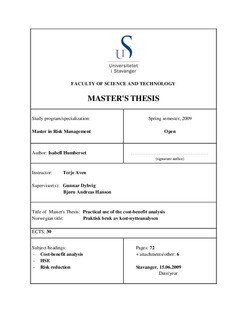Practical use of the cost-benefit analysis
Master thesis
Permanent lenke
http://hdl.handle.net/11250/181895Utgivelsesdato
2009Metadata
Vis full innførselSamlinger
- Studentoppgaver (TN-ISØP) [1428]
Sammendrag
The petroleum industry is Norway’s most important trade, and has been an important contributor to the economic growth for the last 30 years. The industry has nonetheless also inflicted, and will continue to inflict the society with considerable consequences, affecting both humans and the environment. The cost-benefit analysis is a well known and widely used analysis in respect to risk-reduction. Its main purpose is to identify and quantify all the advantages and disadvantages from the different projects and to rank them according to their expected net present values. It is also a much disputed analysis, as some people find it unethical to transform every element of the analysis into a monetary value, including human life and environmental influence.
What we will try to visualise, is how some companies in the petroleum industry uses the cost-benefit analysis in respect to risk reduction, and how it is carried out with regard to legislations and the trends in the risk level. A theoretical interpretation of the cost-benefit analysis, and other risk analysis that are used as quality assessment, will be given first, to show the composition of the analysis.
Legislations and good offshore practice must be the underlying causes in every decision. Even though all the companies involved are international companies and therefore subject to both national and international legislations and demands, in this context the Norwegian legislations have been of importance.
When including the development in the risk level, the most important factor was to find out whether the risk level might affect the valuations and implementation in the cost-benefit analysis. But it rather showed a mutual influence between the risk level and the cost-benefit analyses’ risk reducing measures. Even though the risk level affects the cost-benefit analysis, in the sense that there is still room for improvements, it is also visible that risk-reducing measures have had its effect on the risk level. There has been a visible reduction in accidents over the past few years, both in respect to personnel and to the environment.
Beskrivelse
Master's thesis in Risk management
